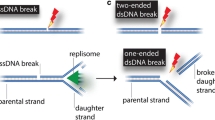Abstract
Double-strand breaks arise frequently in the course of endogenous – normal and pathological – cellular DNA metabolism or can result from exogenous agents such as ionizing radiation. It is generally accepted that these lesions represent one of the most severe types of DNA damage with respect to preservation of genomic integrity. Therefore, cells have evolved complex mechanisms that include cell-cycle arrest, activation of various genes, including those associated with DNA repair, and in certain cases induction of the apoptotic pathway to respond to double-strand breaks. In this review we discuss recent progress in our understanding of cellular responses to DNA double-strand breaks. In addition to an analysis of the current paradigms of detection, signaling and repair, insights into the significance of chromatin remodeling in the double-strand break-response pathways are provided.
Similar content being viewed by others
Author information
Authors and Affiliations
Corresponding author
Rights and permissions
About this article
Cite this article
Karagiannis, T.C., El-Osta, A. DNA damage repair and transcription. CMLS, Cell. Mol. Life Sci. 61, 2137–2147 (2004). https://doi.org/10.1007/s00018-004-4174-0
Issue Date:
DOI: https://doi.org/10.1007/s00018-004-4174-0




